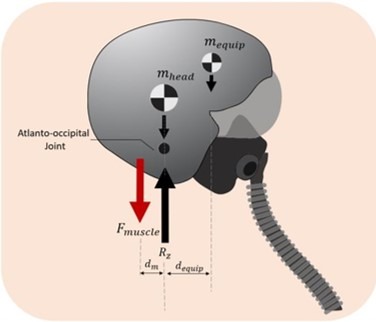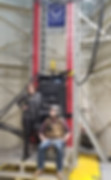Conclusion
The LEET is a generalizable approach that can be applied to assist anyone experiencing neck pain due to head mounted weight or awkward work-related postures. It can also be applied to other joints. We envision future versions that support the ankle of paratroopers and the backs of cargo loaders and boom operators working on in-air refueling aircraft such as the KC-135 during refueling and during their cargo-loading operations.
The E-LEET is now available to order!
On the Horizon
the Naval Air Warfare Center Aircraft Division (NAWCAD) has placed a pre-order for the E-LEET with helicopter pilots in mind. The cervical spine research lab will test the system in a helicopter simulator at the Patuxent River Naval Air Station.
It is exactly this kind of work that drives all of us at ESTAT. ESTAT was founded to provide better robotic hardware to enable mobility products such as prostheses and exoskeletons. We are proud to serve our military through the Air Force and the Navy. We are excited to have dual-use system supporting our essential workers.


ESTAT delivered a LEET for early evaluation. When trying the system for the first time, Dr. Andrews rested his head on the counterbalance and said “This feels nice…I can just chill…This is big. You guys are going to enable adoption.”
Fatigue Prevention
The next steps for LEET development is user efficacy testing. To this end, ESTAT has produced the Evaluation LEET, or E-LEET. This system is designed to enable researchers to explore ExoTendon assistance for neck and back support. It attaches easily to a user via a simple suspender system and head attachment. It is available for sale to early adopters and researchers.
Our first customer, UPMC’s Surreality Lab, has purchased two LEETs to support surgeons during long surgeries during which their heads are inclined and their neck muscles strained. The NIH reports that 74% of spine surgeons report neck pain. This is a much higher prevalence than the general public. However, there are few to no solutions on the market to address this problem.
Dr. Ted Andrews, Neurosurgeon and co-founder of the Surreality Lab is exploring the use of augmented reality during surgery for superimposing preoperative scans on the patient or providing essential data. This technology promises to improve focus and accuracy during surgery. While the augmented reality goggles add significant advantages, it is heavy and furthers the strain surgeons are already experiencing.
When discussing this issue Dr. Andrews stated: “Counterbalancing and comfort is essential to the success of AR in surgery. We must be able to wear the goggles from start to end of each procedure to reap the full benefits.”
Some example data is shown below for a 10 G test. This data shows dramatic improvements across all MANIC injury criteria. Most notably, our small manikin experienced a 79% reduction in injury risk as measured by MANICz which measures risk due to tension in the neck. In the unassisted case, the small occupant faces nearly a 50% chance of becoming seriously injured as a result of tension in the neck (MANICz). When assisted, the probability of injury dropped to less than 11%.

The probability of injury with and without assistance is shown as measured by the Multi Axis Neck Injury Criteria score. Both large and small subjects experience significant improvements in injury risk across several different injury measures.

Dramatic Benefits at high-G
ESTAT completed high acceleration testing of the LEET at Wright Patterson Air Force Base with the support of the 711th Human Performance Wing who sponsored the SBIR project.
ESTAT tested two versions of the LEET across a range of G levels (6, 10 and 15). The system was tested on both large and small manikins. The success of the system was measured by the Multi Axis Neck Injury Criteria score (MANIC). MANIC is a measure defined and used by the US Air Force to quantify injury risk.

The LEET:
a Solution to Neck Pain

Light-weight
Electroadhesive
ExoTendon
Introduction
ESTAT is dedicated to supporting the US Air Force and Navy by developing ExoTendon systems to prevent injuries. What began as an SBIR project focused on improving neck safety for Fighter Pilots has evolved into a product already being sold for evaluation in both military and medical applications by surgeons.
This case study will outline the challenge of head-mounted equipment, explain how ESTAT's electroadhesive devices provide a solution, present experimental and simulation data to demonstrate their effectiveness, and highlight recent commercial achievements. We also offer a glimpse into ESTAT's design process.
The Problem
Head-mounted equipment, while advantageous for pilots and surgeons, repositions the head's center of mass, leading to an upward and forward shift. This shift strains neck muscles and joints, significantly increasing pilots' risk of injury, especially during ejection.
The Air Force faces a critical shortage of 1900 pilots directly attributed to neck pain. Annually, 97% of Joint Helmet Mounted Cueing System (JHMCS) users report post-flight pain, and 616 out of every 1000 F-22 pilots suffer neck injuries. This issue severely compromises the Air Force's readiness and incurs over $184 million in annual costs related to pilot neck and back injuries.
Despite decades of effort, solutions for this problem have either lacked efficacy or pilot acceptance.
As illustrated by the free body diagram (right) of a pilot's head and neck extensor muscles, head-mounted equipment increases head mass and shifts the center of gravity forward. This necessitates greater force from the neck extensor muscles to maintain an upright posture, ultimately resulting in chronic pain and fatigue.

The Solution
The LEET is a body-worn device designed to support the neck of pilots and other end-users by counterbalancing head-mounted equipment and redirecting loads to the a harness. It integrates with standard air flight equipment, is battery operated, and completely self-contained.
How it Works
System Overview
The LEET is enabled by ESTAT’s unique electroadhesive clutches. The thin and flexible LEET is worn on the pilot’s back. A spring-based mechanism provides the right force to counterbalance the weight of head-mounted equipment without adding weight to the helmet.
Forces from this counterbalance mechanism are transmitted from the helmet to the pilot’s harness using a tether that acts as an ExoTendon to augment the wearer's natural neck musculature.
The user experiences the LEET as a force tugging up on their parachute harness and down on the back of the helmet. The system is capable of transitioning seamlessly between modes to provide the right kind of protection at the right time.

Smart Mode Switching
The LEET provides the right assistance at the right time by automatically sensing the need to transition between three operating modes: Support, Protect, and Transparent.
Support Mode: The LEET alleviates chronic fatigue and pain by acting as a spring to counterbalance the weight of helmet-mounted equipment.
Protect mode: the LEET prevents acute injury by sensing a high G event such as ejection and locking the tether to hold the head in place. This redirects forces from the head to the body and protects the neck. This is very similar to the way guy wires on cell towers redirect wind forces to the ground.
Transparent mode: Tethers go slack to get out of the way.
This ability to transition between modes with an incredibly lightweight, compact and power efficient system sets the LEET apart from other exoskeleton technologies. The system is passive, contains no motors, and is smart.

Simulation Results
While Manikin testing is the current standard for interventions during high G, it does not capture the full human response and may not provide indication of new injury modes that are not captured by MANIC or the manikin’s sensors.
To address this concern, ESTAT partnered with Dr. Jeff Reinbolt and Dr. Anita Vasavada to produce an OpenSim model of the LEET system. This model includes the human response, which demonstrates improvements in injury risk for pilots of all sizes in multiple high G scenarios.
According to their simulation results, the LEET can reduce injury risk by as much as 95% during ejection. No new injury modes with significant risk were identified.

The Ejection Scenario
During the catapult phase of ejection, the pilot can experience 12-15Gs of vertical acceleration. The head whips forward during the catapult phase, rebounds and then is subject to wind blast when they clear the cockpit which causes further whiplash. The LEET senses ejection and locks the tethers to stabilize the head during this violent event.
How it Works
The Future of the LEET-F
ESTAT is finishing the design of the LEET-F 2.0 which will feature multiple tethers and dramatically reduced size. This system will be subjected to mil-spec testing in Summer 2024.
Manikin testing will be performed at the 711th Human Performance Wing at Wright Patterson Air Force Base in Winter 2024. This testing will include the Vertical Deceleration Tower (right) which will subject the system to the accelerations experienced during ejection.

Dr. Kirby Witte, VP of Engineering, and Dr. Ben Shafer, Post-Doctoral Research Engineer, visit Wright Patterson Air Force Base to plan for manikin testing on the Vertical Deceleration Tower.

Dr. Ben Shafer, ESTAT’s resident kinesiologist and Research Engineer, experiences what it is like to be a Boom Operator inside the Boom Operator Simulator System (BOSS) at the 171st Refueling Wing with the help of Boom Operator and Trainer, Randy Reese.
The Future of ESTAT’s LEET Product Line
ESTAT plans to extend LEET protection to other members of the Air Force, specifically Boom operators on the KC-135. Boom operators have to maintain an extreme posture (see left) for hours on end. Using their neck muscles to support the weight of their heads for such long periods of time is severely taxing. This is another great application for ESTAT’s LEET.
We are excited to be working with Justin Jones, Innovation Officer at the 171st Refueling Wing, to promote a proposed LEET for Boom Operators, the LEET-B. We are also grateful for the support of Wing Commander Col. Hyland and are excited to be supporting our local Pittsburgh-based Air National Guard.
Reach Out
ESTAT is interested in learning more about careers with unique musculoskeletal risks. If you have a potential application for LEET technology and would like to discuss, let us know!

